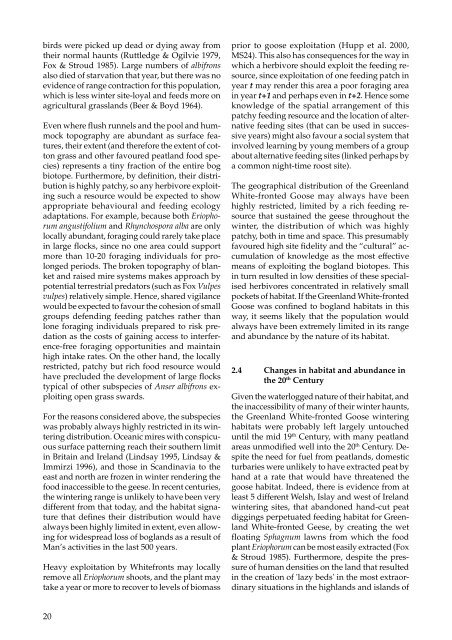The Greenland White-fronted Goose Anser albifrons flavirostris
The Greenland White-fronted Goose Anser albifrons flavirostris
The Greenland White-fronted Goose Anser albifrons flavirostris
Create successful ePaper yourself
Turn your PDF publications into a flip-book with our unique Google optimized e-Paper software.
irds were picked up dead or dying away from<br />
their normal haunts (Ruttledge & Ogilvie 1979,<br />
Fox & Stroud 1985). Large numbers of <strong>albifrons</strong><br />
also died of starvation that year, but there was no<br />
evidence of range contraction for this population,<br />
which is less winter site-loyal and feeds more on<br />
agricultural grasslands (Beer & Boyd 1964).<br />
Even where flush runnels and the pool and hummock<br />
topography are abundant as surface features,<br />
their extent (and therefore the extent of cotton<br />
grass and other favoured peatland food species)<br />
represents a tiny fraction of the entire bog<br />
biotope. Furthermore, by definition, their distribution<br />
is highly patchy, so any herbivore exploiting<br />
such a resource would be expected to show<br />
appropriate behavioural and feeding ecology<br />
adaptations. For example, because both Eriophorum<br />
angustifolium and Rhynchospora alba are only<br />
locally abundant, foraging could rarely take place<br />
in large flocks, since no one area could support<br />
more than 10-20 foraging individuals for prolonged<br />
periods. <strong>The</strong> broken topography of blanket<br />
and raised mire systems makes approach by<br />
potential terrestrial predators (such as Fox Vulpes<br />
vulpes) relatively simple. Hence, shared vigilance<br />
would be expected to favour the cohesion of small<br />
groups defending feeding patches rather than<br />
lone foraging individuals prepared to risk predation<br />
as the costs of gaining access to interference-free<br />
foraging opportunities and maintain<br />
high intake rates. On the other hand, the locally<br />
restricted, patchy but rich food resource would<br />
have precluded the development of large flocks<br />
typical of other subspecies of <strong>Anser</strong> <strong>albifrons</strong> exploiting<br />
open grass swards.<br />
For the reasons considered above, the subspecies<br />
was probably always highly restricted in its wintering<br />
distribution. Oceanic mires with conspicuous<br />
surface patterning reach their southern limit<br />
in Britain and Ireland (Lindsay 1995, Lindsay &<br />
Immirzi 1996), and those in Scandinavia to the<br />
east and north are frozen in winter rendering the<br />
food inaccessible to the geese. In recent centuries,<br />
the wintering range is unlikely to have been very<br />
different from that today, and the habitat signature<br />
that defines their distribution would have<br />
always been highly limited in extent, even allowing<br />
for widespread loss of boglands as a result of<br />
Man’s activities in the last 500 years.<br />
Heavy exploitation by <strong>White</strong>fronts may locally<br />
remove all Eriophorum shoots, and the plant may<br />
take a year or more to recover to levels of biomass<br />
20<br />
prior to goose exploitation (Hupp et al. 2000,<br />
MS24). This also has consequences for the way in<br />
which a herbivore should exploit the feeding resource,<br />
since exploitation of one feeding patch in<br />
year t may render this area a poor foraging area<br />
in year t+1 and perhaps even in t+2. Hence some<br />
knowledge of the spatial arrangement of this<br />
patchy feeding resource and the location of alternative<br />
feeding sites (that can be used in successive<br />
years) might also favour a social system that<br />
involved learning by young members of a group<br />
about alternative feeding sites (linked perhaps by<br />
a common night-time roost site).<br />
<strong>The</strong> geographical distribution of the <strong>Greenland</strong><br />
<strong>White</strong>-<strong>fronted</strong> <strong>Goose</strong> may always have been<br />
highly restricted, limited by a rich feeding resource<br />
that sustained the geese throughout the<br />
winter, the distribution of which was highly<br />
patchy, both in time and space. This presumably<br />
favoured high site fidelity and the “cultural” accumulation<br />
of knowledge as the most effective<br />
means of exploiting the bogland biotopes. This<br />
in turn resulted in low densities of these specialised<br />
herbivores concentrated in relatively small<br />
pockets of habitat. If the <strong>Greenland</strong> <strong>White</strong>-<strong>fronted</strong><br />
<strong>Goose</strong> was confined to bogland habitats in this<br />
way, it seems likely that the population would<br />
always have been extremely limited in its range<br />
and abundance by the nature of its habitat.<br />
2.4 Changes in habitat and abundance in<br />
the 20 th Century<br />
Given the waterlogged nature of their habitat, and<br />
the inaccessibility of many of their winter haunts,<br />
the <strong>Greenland</strong> <strong>White</strong>-<strong>fronted</strong> <strong>Goose</strong> wintering<br />
habitats were probably left largely untouched<br />
until the mid 19 th Century, with many peatland<br />
areas unmodified well into the 20 th Century. Despite<br />
the need for fuel from peatlands, domestic<br />
turbaries were unlikely to have extracted peat by<br />
hand at a rate that would have threatened the<br />
goose habitat. Indeed, there is evidence from at<br />
least 5 different Welsh, Islay and west of Ireland<br />
wintering sites, that abandoned hand-cut peat<br />
diggings perpetuated feeding habitat for <strong>Greenland</strong><br />
<strong>White</strong>-<strong>fronted</strong> Geese, by creating the wet<br />
floating Sphagnum lawns from which the food<br />
plant Eriophorum can be most easily extracted (Fox<br />
& Stroud 1985). Furthermore, despite the pressure<br />
of human densities on the land that resulted<br />
in the creation of 'lazy beds' in the most extraordinary<br />
situations in the highlands and islands of


